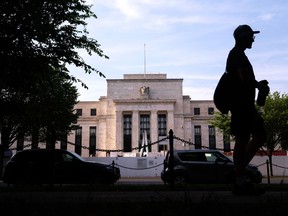Economist says Fed is stuck on a self-defeating pivot

Article content
Torsten Slok is one of Wall Street’s most closely followed economists. After earning his PhD, he has worked for the International Monetary Fund, the Organization for Economic Co-operation and Development, and Deutsche Bank AG. He is currently a partner and chief economist at Apollo Global Management Inc. He recently spoke with Unhedged.
Unhedged: We’ve been reminded in the last four or five years that economics is not a predictive science. Given that Wall Street is in the prediction business, what is the role of someone with economics training in markets?
Advertisement 2
Article content
Article content
Slok: Connecting the dots. When I look at my screen, there are 20 different stories and they go in all kinds of directions. There is a 30-year Treasury auction at 1 p.m. Some economic data comes out. A Fed governor is giving a speech. The yield curve is flattening. How is all this connected? The economics textbook can provide a framework for thinking about what’s going on. Maybe there’s more Treasury supply coming in the long end, so it is not only driven by what the Fed is doing, it is also driven by supply. So, it’s saying why are things trading the way they are, putting that into an economic framework, and explaining it in intuitive terms. And that’s the real differentiator between all the Wall Street chief economists: can you communicate what’s going on, or can you not?
Unhedged: One of your out-of-consensus views is that there will be no cuts this year. Can you connect the dots on that?
Slok: It starts very simply with the story that was told all of last year. There are lagged effects of Fed hikes. They will slow the economy down, and it takes 12 to 18 months. As a result, everyone went into last year saying we will have a hard landing because of the negative effect on consumers, firms and banks.
Advertisement 3
Article content
Which consumers have been impacted? Look at delinquency rates for credit cards for people in their 20s and 30s. Young households have three characteristics: they have more debt, lower credit scores, lower incomes. It’s not surprising that those households have been negatively impacted by rates going up. Likewise, for auto loans, people in their 30s are now falling behind on their loans at a faster pace than during the pandemic. Think about that: 2008, people lost their jobs, so of course they stopped paying the bills. Today, no one’s lost their job. We just created 275,000 jobs and still more and more young households are falling behind.

This is exactly what the textbook would have predicted. If you raise interest rates, more indebted households begin to see negative consequences. You see the same thing when you look at savings — the amount of money people have in checking and savings accounts across the income distribution. Look at people who make less than US$25,000 a year. They are out of stimulus cheques, unemployment benefits, child-care tax credits, and the money they might have saved because they didn’t go to restaurants, hotels or sporting events. Their savings today are lower than where they were in 2019. Likewise for people making between US$25,000 and US$45,000 a year. The median income in the U.S. is US$70,000: they have a little bit left, but all the excess savings and all the support for consumer spending is today coming from the top 20 per cent of incomes.
Article content
Advertisement 4
Article content
The top earners account for 40 per cent of consumer spending. These are the households still paying thousands of dollars for Taylor Swift concert tickets, Super Bowl tickets. They still go to hotels, cruise lines, sporting events, concerts. The bottom line is that the Fed raised rates and rates going up has had a distributional impact. Those who have debt have been negatively impacted, those who have assets have been positively impacted because the stock market is at all-time highs, home prices are very high, even bitcoin prices are high.
Unhedged: You’ve just given me some reason to think that the Fed needs to cut, and you think they’re not going to. This seems paradoxical.
Slok: Young households don’t account for a significant share of consumer spending. Now, look at the firms that are being impacted. Again, it is what the textbook would have predicted. When rates go up, the most highly levered companies experience the most distress. They have high debt, low coverage ratio, weaker earnings. As a result of that, we’ve seen a lot of distressed exchanges, with firms lowering debt and increasing equity, and not mass layoffs. That is by definition a default, according to the rating agencies. That’s why default rates have been moving higher. But again, the investment-grade market is about US$9 trillion outstanding. High yield and loans are around US$1 trillion each. So even with those two seeing distress, at the macro level we have not seen the slowdown many expected.
Advertisement 5
Article content
Those who have debt have been negatively impacted, those who have assets have been positively impacted
Torsten Slok
Unhedged: So, we had a hard landing for 10 per cent of the economy.
Slok: Exactly. Rate hikes have had an impact. But it has only had an impact on those highly levered balance sheets for consumers, firms and banks that are vulnerable to commercial real estate. That was the story last year, and that story continues. But the story today has changed dramatically because of what the Fed did in December, and because of the (Fed governor) Christopher Waller speech in November. The Fed sits down around the table and says, ‘OK, what do we think the fed funds rate will be by the end of 2024?’ And starting in 2021, at every meeting, they came back and said, ‘Rates will go higher than we thought last time.’ Rates are going higher, higher, higher was the message from the Fed for 18 months. And it was only when they came in last December and said, ‘You know what? We don’t think rates are going higher; we can begin to cut rates.’
This meant that a lot of people who were sitting on the fence and waiting, now they’re saying, ‘This is the green light for risky assets to go up.’ Check out how much the stock market has risen on the back of this. Financial conditions have eased spectacularly. The S&P 500, investment-grade spread, high-yield spread, loan spread, the level of rates, home prices, crypto, M&A activity, IPO activity, everything improved after the Fed signalled that rates are going lower.
Advertisement 6
Article content
But the bottom line is, financial conditions have a strong correlation with real (gross domestic product). So, if you ask me what is the outlook for the economy right now, it may be not surprising that payrolls were strong in January and February. And the economy has begun to reaccelerate. The conclusion is the Fed pivot and the easy financial conditions that followed are creating exactly what we’re seeing.
Similarly, we may be seeing re-acceleration in inflation. Look at CPI (consumer price index). The Fed target mandated by Congress is that it should be two per cent. We’re at three; we’re just not there yet. Look at the three months and the six months annualized change in core CPI. We’re beginning to see inflation go up again, because of this strong tailwind coming from easy financial conditions.

Unhedged: Is the economic combination you have described — strength overall, with acute pressure at the perimeter from higher rates — sustainable, or is it fragile?
Slok: Everyone is saying we’ll have a soft landing. But there are bumps on this road that we are driving down. The bump on the left is rates staying higher for longer because inflation stays higher for longer. If the Fed still does quantitative tightening and reverse repo balances go down to zero in May and June, you can have things go wrong in the plumbing of the financial system, in the regional banks, in commercial real estate. There are just a lot of different balance sheets that are being impacted as the Fed continues to withdraw liquidity more and more, and keeps interest rates at higher levels. The bump on the right is that you actually begin to see an acceleration of growth that’s so strong that the Fed has to hike again. That’s not my base case at all, but that would be the mother of all pain trades. No one is preparing for that risk.
Advertisement 7
Article content
And let’s not forget — and this is the topic of the year — yesterday, we had a 10-year Treasury auction. Today, we have a 30-year auction. The Treasury Borrowing Advisory Committee thinks Treasury issuance will be way up all across the yield curve in 2024. Look at five-year notes: auction sizes will be 41 per cent bigger in 2024. Across the whole curve, it’s 35 per cent. Normally, it’s very easy: when the economy goes down, long rates go down. When the economy goes up, long rates go up. But today, there is a new factor in town, which is Treasury supply. Who’s going to buy when auction sizes increase so much? What does it mean when you think about the fiscal deficit?
Everyone is saying we’ll have a soft landing. But there are bumps on this road that we are driving down
Torsten Slok
Unhedged: The picture you’re drawing is one in which the Fed might face very difficult decisions. The last mile of inflation is difficult to defeat, and yet there are significant fragilities in the financial system that high rates exacerbate.
Slok: I think that the financial system is very stable. I would not characterize it as having a lot of fragilities. I would say simply that if you keep the cost of capital high, page one in your finance textbook will tell you that will have some consequences for households and firms that have a lot of debt, and on banks that have vulnerabilities to interest rates. We can then debate, where are those vulnerabilities? Are they dramatic? Are they small? But it’s very clear that the Fed turning dovish has unleashed some significant easing of financial conditions, and that’s helpful for alleviating some of these problems, but you still have this background of the cost of capital biting into balance sheets every single day.
Advertisement 8
Article content
Unhedged: What keeps the Fed from cutting this year?
Slok: Financial conditions are so easy, which is supporting consumer spending over the next several quarters in a very significant way. Excitement about AI (artificial intelligence) is also easing financial conditions. Now there’s a whole exogenous story that has just come from left of centre. We can spend a lot of time thinking about whether AI is great or not, but if the stock market wants to go up, think about it in terms of financial conditions. The Fed is trying to slow the economy down.
Very simply, the goal of raising interest rates is for you and me to buy fewer cars, for you and me to spend less money on our credit cards, for you and me to buy fewer houses. It is supposed to slow the economy down. Now, out of the blue, AI comes along, the stock market goes up, financial conditions ease dramatically. It doesn’t take much creativity to say, well, maybe the Fed actually has to keep rates higher for longer, maybe even hike a little bit, to make sure that it can neutralize the effects of the AI story.

We will see strong spending for consumers in the next several quarters. We’ll see particularly strong spending for services: airlines, hotels, restaurants, concerts, sporting events, everything that’s getting a huge tailwind as a result of people having more money, both cash flows from their fixed-income investments and also in the assets that they’re holding, stocks and houses.
Advertisement 9
Article content
Unhedged: We’re struck by how tight credit spreads have become. They are about as tight as they ever get. We’re sitting here thinking, why wouldn’t you just own the Treasuries?
Slok: There are four reasons why credit spreads are so tight. By far the most important one is that the Fed is now telling me that inflation is no longer a problem. If you are a fixed-income investor, you want to lock in this level of yields before it starts moving lower. The three other things are more technical. When rates went up, pension funds saw the stock market go up and rates go up. A lot of pension funds had not been fully funded. So, they switched out of equities and locked in credit (to match their assets with their liabilities). This has unleashed significant demand for credit. The third thing is that annuity sales have gone up for life insurance companies. Remember that when rates go up, annuities pay a higher return. So, the insurance industry has sold more annuities and used the proceeds to buy credit. The final thing is retail. Households are saying, if the Fed tells me rates are going to go down and I’m hunting yield and I have some extra cash in money market funds, why don’t I buy credit? I get some extra spread.
Advertisement 10
Article content
Unhedged: I see the demand story, but how appealing is credit, really, as opposed to just owning the sovereign?
Slok: In some cases, triple-C, even single-B credit looks more vulnerable, because those are the firms that are more vulnerable to higher interest rates. These firms still have good earnings and decent cash flows because the economy is still doing fine. But the fact that rates going up has had this negative impact. That’s why in credit you need to be much more selective, so that you stay away from those firms that have the highest leverage, the lowest coverage ratios and the weakest cash flows.
Unhedged: To return to inflation, core inflation looks scary, but a huge chunk of that is the shelter inflation story, where we haven’t seen the CPI measure converge with more timely indices from places like Zillow. What’s going on?
Slok: Look at the Zillow and Apartment List indices. Then look at the Case-Shiller home price index. What’s Case-Shiller doing? It’s rebounding. Housing is recovering. So, it wouldn’t take much to come to the conclusion that maybe OER (owner’s equivalent rent, a CPI component) is not going to come crashing down. Maybe it is beginning to flatten out. Could it be that OER is moving more slowly down because the housing market is actually recovering? Absolutely. You see it right here.
Advertisement 11
Article content
When tech stocks go up, it eases financial conditions. That’s making the job a lot harder for the Fed
Torsten Slok
You can slice and dice the inflation data, and trust me, I’ll sit here with my PhD in economics and do that all day long. But you are in the FOMC (Federal Open Market Committee), sitting around the table, you’re saying inflation has come down from the peak in 2022. That’s great. And went down from nine per cent to roughly three. But honestly, it looks like inflation is sticky at three, and we are just not moving down to two. And I know people love excluding this, that and the other thing, and you get something that’s low. But let’s be honest, that’s just not what the data is showing. We’re sticking a three on headline, on core, we are beginning to reaccelerate.
The dot plot also tells you that there is quite a debate (in the FOMC) about where we’re going. There are some who think that the fed funds rate in the long run is going to be a lot higher than the two and a half per cent (median). Yes, it’s been relatively easy so far. But when inflation begins to reaccelerate with a strong tailwind from easy financial conditions, that is neutralizing a lot of the rate hikes they have done so far. We have a bumpy road ahead.
Advertisement 12
Article content
Unhedged: Let’s turn to equities. Consensus says the excitement at the top end of the stock market is grounded in fundamentals, unlike in 1999. You seem to disagree.
Slok: Look at the trailing price/earnings ratio. The forward P/E can be anything; if we have a soft landing, the future will look good, if we have a hard landing, the future will look bad. What is the trailing P/E ratio of the top-10 stocks in the S&P 500 today? They are more overvalued than the top 10 were in the tech bubble. You can say there’s earnings, but there were earnings in 1999, too. Maybe the Magnificent Seven look good. But all the literature on bubbles tells you there might be a few winners, and that could be a handful of stocks. We’ll figure it out over time. But there is a whole crowd of other firms that come running into the same idea. OK, Nvidia did well, and maybe that stock should be trading maybe where it is, maybe not. We can discuss that. But all the other firms that are coming in, if you have 10 tech firms the best guess is that out of those 10 firms, nine firms will go bankrupt.
Recommended from Editorial
-

Federal Reserve holds rates, still signals 3 cuts in 2024
-

Wall Street’s ‘foolish’ 2024 trade is betting on early rate cuts
-

IPO investors hope Federal Reserve is finally ready to restart party
Unhedged: So, you think we’re in a bubble?
Slok: We are absolutely in an AI bubble, and the side effect of that is that when tech stocks go up, it eases financial conditions. That’s making the job a lot harder for the Fed.
© 2024 The Financial Times Ltd.
Article content
Federal Reserve won’t cut interest rates in 2024, Apollo’s Slok says
2024-03-25 10:00:25







